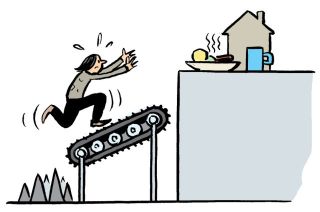The Cost of Living Crisis

Everyone has experienced the recent increases in the cost of living. But not everyone experiences these increases evenly. Analysis by the CSO indicates that, while all households experienced an average rate of inflation of 8.2 per cent in the year to September 2022, households in the lowest ten per cent of the income distribution experienced an inflation rate of 9 per cent, while those at the top of the income distribution experienced a rate of just 7.5 per cent (CSO, 2022). Viewed over five-year period, overall inflation rose by 12.9 per cent, while the poorest ten per cent experienced an inflation rate of 15 per cent and the richest, just 11.6 per cent (CSO, 2022).
Broken down by contribution, in the year to September 2022, the poorest ten per cent of households experienced an inflation rate on food and non-alcoholic beverages that was almost twice that of the richest ten per cent (1.4 per cent compared to 0.8 per cent); inflation on rent experienced by the poorest was more than three times that of the richest (1.8 per cent compared to 0.5 per cent); and inflation in electricity, gas, and other fuels was 1.5 times higher for poorer households than richer ones (2.9 per cent compared to 1.6 per cent) (CSO, 2022).
These differences may not seem significant, however given that the poorest households spend almost half of their income on food and energy, compared to less than 10 per cent of income for those in the top ten per cent (Central Bank of Ireland, 2022), these increases are causing significant strain on those least able to absorb it.
Higher income households are also more likely to have savings. Analysis by the Central Bank of Ireland shows a significant correlation between income decile and savings rate, with those in the bottom (poorest) ten per cent having a negative savings rate of minus 33 per cent. This means that these expenditure for these households exceeds their income by one third. Meanwhile households in the top ten per cent have a savings rate of approximately 70 per cent (Central Bank of Ireland, 2022). Actual savings on deposit for the poorest ten per cent equate to approximately €1,000, compared to more than €25,000 for the richest (ibid.).
In our Budget Choices 2023 policy brief, we called on Government to protect the incomes of the poorest, specifically increasing core social welfare rates by €20 per week (Social Justice Ireland, 2022a). Government chose not to act on this proposal, and instead increased core social welfare rates by just €12 per week, a reduction of €8 in real terms when inflation is factored in. Following the announcement of Budget 2023, Social Justice Ireland highlighted the disparity of its impact, providing token one-off payments to the poorest, while increasing the Rich-Poor Gap by €199 over the year(Social Justice Ireland, 2022b). We were not alone in identifying the inadequacies in Budget 2023 and highlighting the need for additional measures in 2023, others such as the ESRI citing a need for additional measures in 2023, benchmarking social welfare payments and linking payments to income adequacy (Doolan, Doorley, Regan, & Roantree, 2022).
In February 2023, just as the year before, the Government announced a series of additional, one-off, measures to support low-income households with the cost of living[1]. While welcome, these measures do not go far enough. A one-off payment is not a response to a continuous crisis of income inadequacy.
The cost-of-living crisis is an issue of adequate income. In 2023 the core rate for Jobseekers Benefit for a single adult (aged 25+) is €220 per week. €220 a week to provide for accommodation costs, heat, light, food, clothing, personal care, entertainment, education, transport, tv licence, communications, refuse collection, households goods, health, insurances, bank charges and in an ideal world allow for savings for contingencies. This is an impossible challenge. One-off measures fail to deal with the reality of the unavoidable trade‐offs people living on inadequate incomes have to make because core social welfare rates are inadequate
[1]gov.ie - Government announces new cost-of-living measures for families, businesses and the most vulnerable (www.gov.ie)
Central Bank of Ireland. (2022). Quarterly Bulletin Q3 2022. Dublin: Central Bank of Ireland.
CSO. (2022). Estimated Inflation by Household Characteristics September 2022. Cork: Central Statistics Office. Retrieved from https://www.cso.ie/en/releasesandpublications/frp/frp-eihc/estimatedinf…
Doolan, M., Doorley, K., Regan, M., & Roantree, B. (2022). ESRI Special Article: Distributional impact of tax and welfare policies: Budget 2023. Dublin: ESRI.
Social Justice Ireland. (2022a). Budget Choices. Dublin: Social Justice Ireland.
Social Justice Ireland. (2022b). Budget 2023 Analysis and Critique. Dublin: Social Justice Ireland.